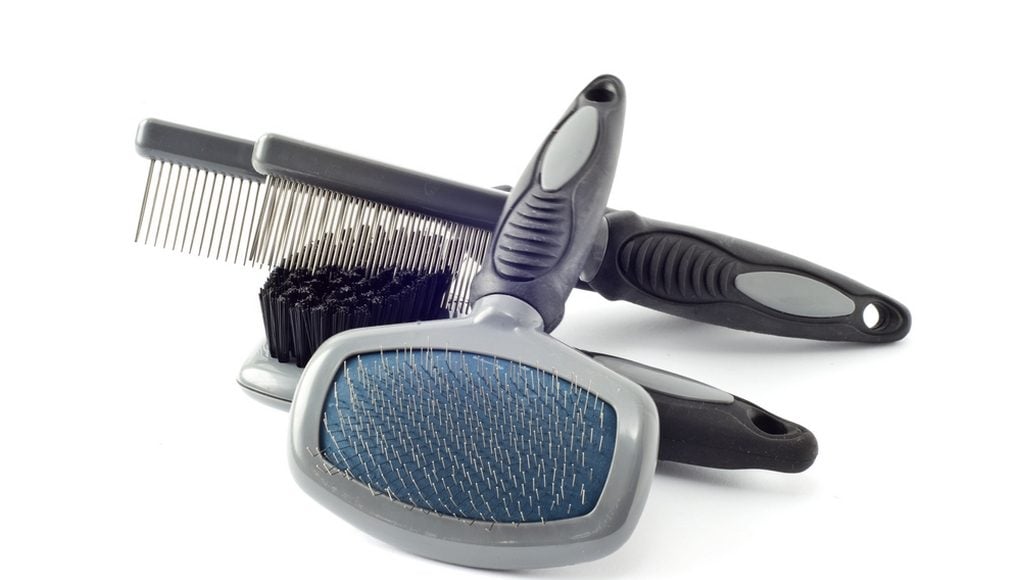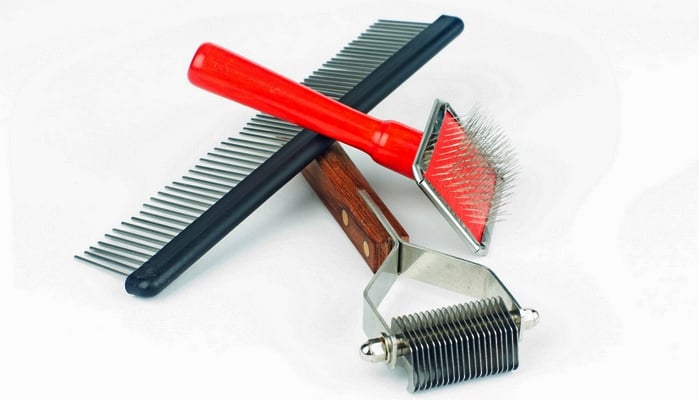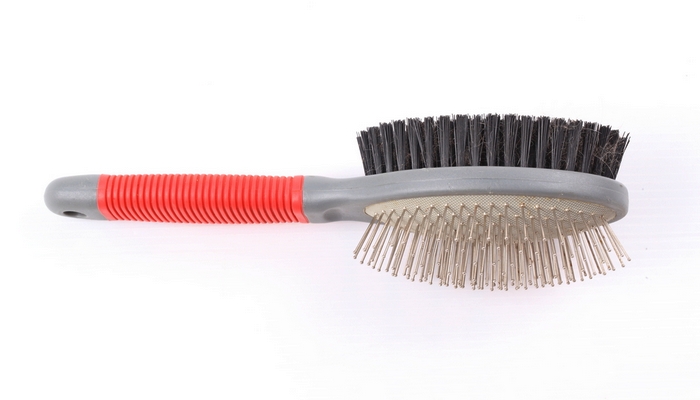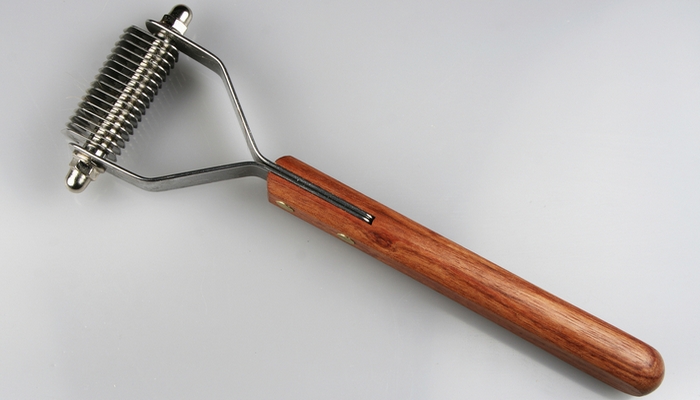As if grooming your dog at home isn't confusing enough, there are so many dog grooming products available it will make your head spin! How do you know which products to use? Well, it all depends on your dog and his needs. This week I want to talk about the different types of dog brushes and their uses. Brushes will need to be selected based on your dog's coat type and his size.
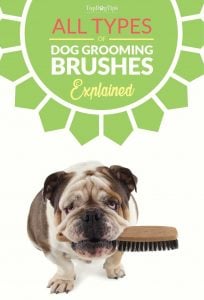 There are many different shapes and sizes of dog brushes, but there is more to it than that. Each type of dog brush is used for a different reason. Some will brush out long tangled hair, while others are meant for dematting or deshedding. It's really important to do a bit of research before you start shopping for the best dog brush for your pet.
There are many different shapes and sizes of dog brushes, but there is more to it than that. Each type of dog brush is used for a different reason. Some will brush out long tangled hair, while others are meant for dematting or deshedding. It's really important to do a bit of research before you start shopping for the best dog brush for your pet.
If you're not sure what type of coat your dog has, that's the first thing you need to figure out. Here's a tip: if your dog's hair continuously grows, that means it is hair and if it stops growing at a certain length, that means he has fur. You'll also need to note whether his coat is thick or thin, long or short, and how much your pet sheds.
It's also best to know if your dog has a double coat or any skin conditions that you need to be careful of. A bit of research online can help with this, but you also may want to seek the advice of a professional groomer. It's worth paying to have your dog groomed professionally once just to hear the groomer's tips and tricks.
Types of Dog Grooming Brushes and Their Uses
Once you understand the type of coat that your pet has, you can select the type of brushes and combs that will work best to groom him. Keep in mind that you will probably be purchasing more than one brush.
The types of dog brushes all have different uses and you may need two or three brushes to groom your pet appropriately. For example, you may need a brush to remove the tangles and debris from his coat and a deshedding brush to remove the bulk of his loose hair.
Pin and Bristle Brushes
I am grouping these two types of dog brushes together, because you can often find a brush with two heads – a pin brush on one side and a bristle brush on the other. Pin brushes have rows of straight pins that are typically fairly sturdy. These pins are usually tipped with rubber or plastic to keep them from scratching your dog's skin.
RELATED: Dog Shedding Tools: Tips on Choosing the Best Dog Brush
Pin brushes are used to remove tangles from long coats. They work great on dogs like Golden Retrievers, Boarder Collies and Yorkshire Terriers. These brushes are also ideal for dogs with burly or wooly coats, as they won't pull the hair as they brush through.
These are typically the most commonly used dog brushes, but they are also the least effective. They don't remove a lot of loose fur or provide much of a benefit aside from brushing out tangles. Therefore, they are typically used in combination with another type of brush. Pin brushes are great for finish grooming.
The photo above shows a pin brush on the bottom and a bristle brush on the top. Bristle brushes vary based on the length of the bristles and the spacing between them. Typically, the longer your dog's coat is the longer the bristles should be and the more widely spaced they should be as well. Likewise, the courser your pet's fur, the stiffer the bristles will need to be.
These types of dog brushes are best for dogs with short, smooth coats. They are also a good pick for dogs that tend to shed frequently, but not excessively. Both pin and bristle brushes stimulate the skin and encourage the production of natural oils. These natural oils moisturize the skin and provide a beautiful gloss to your dog's coat.
Slicker Brushes
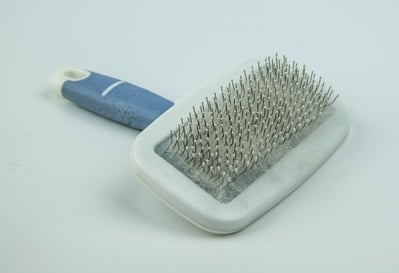 Slicker brushes are very easy to recognize. They usually have a flat, rectangular head, and this head is covered in fine, short wire bristles that are fairly close together.
Slicker brushes are very easy to recognize. They usually have a flat, rectangular head, and this head is covered in fine, short wire bristles that are fairly close together.
Slicker brushes are used for dogs with medium or long hair. They can be used to remove mats and dead hair from the dog's undercoat.
RELATED: Review – MIU COLOR Pet Hair Brush for Dogs
The types of dog brushes are also a good choice for dogs with curly hair. Slicker brushes come in many different sizes, so you'll be able to choose one that is appropriately sized for your Fido. With slicker brushes, you'll need to remember not to apply too much pressure. Their fine wire bristles can easily scratch the skin.
Rakes
If your dog has a double coat or a particularly thick coat, then a rake is something that you'll definitely need in your dog grooming toolbox. These types of dog brushes are made to get deep down into your dog's coat to remove tangles, debris and loose hair that is close to the skin. They are great for breeds including Labradors, Chow Chows, German Shepherds and Malamutes.
Rakes are particularly handy during shedding season. Dogs with thick coats end up developing a lot of dead hair, and it gets stuck underneath the top coat. Rakes can gently pull out his dead hair, reducing shedding drastically and also making your pup feel a lot better.
Brushing your dog's coat is essential, no matter what breed he is. Many people don't think it's necessary to brush dogs with short fur, but it's actually helpful to you and your pet. Brushing your dog will release loose fur that would otherwise be shed in and around your home.
Brushing also helps to remove knots, mats and tangles from your dog's coat. Imagine how a woman with long hair would feel if she never brushed her hair. Eventually, knots and mats will begin to pull the hair causing pain for your pet. Regular brushing is the only way to alleviate this issue.
Brushing is also good for your dog's skin, and healthy skin directly correlates to a healthy coat. Brushing massages your dog's skin and stimulates the production of natural oils. When you run the brush through your dog's coat it spreads these oils around.
If you use the right types of dog brushes on your pet he will surely enjoy a daily brushing. The wrong type of brush may pull his hair or scratch his skin.
If you notice any discomfort at all, consult a professional groomer for advice. You may be using the wrong brush or your dog may have an underlying health condition that is causing the pain. Better to be safe than sorry!


